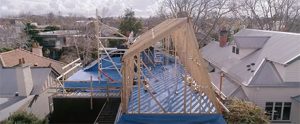The Federal Government’s $688 million HomeBuilder grants scheme has been widely praised by the building industry although there has been criticism of its accessibility and where the money will be spent. Source: Timberbiz
The Homebuilder program which provides up to $25,000 in grants for new homes and major renovation comes after calls for a stimulus package from AFPA and the housing and construction industry.
The Government says the scheme will keep 140,000 jobs in the construction industry through the recession.
However, the federal opposition and community housing sector is pushing the Morrison government to including social housing in its stimulus measures, proposing a $7.2 billion package for new buildings and $500 million for renovation of existing homes.
The HomeBuilder scheme is expected to facilitate between 25,000 and 30,000 builds and renovations.
Under the scheme, eligible singles and couples will receive grants of $25,000 to facilitate home builds or renovations carried out by the end of the year.
Singles must earn under $125,000 a year, while couples must earn under $200,000, to be eligible for the grant. Those applying for the scheme must be owner-occupiers.
New properties must not be valued at more than $750,000, including the land cost, to be eligible, while renovations on existing properties must be valued at between $150,000 and $750,000 to qualify.
The money can’t be used on investment properties or to build things outside the house such as swimming pools, tennis courts, outdoor spas and saunas, sheds or garages.
Work has to be done by a licensed builder, so owner-builders and DIY renovators miss out.
A few factors mean only a certain few will be able to cash in on the scheme.
Queensland University of Technology property economist Andrea Blake says while any stimulus into the sector is positive, there will be winners and losers.
“The project home builders will probably be the winners because of the value thresholds and the earning thresholds on the scheme,” Blake said.
But the scheme’s financial threshold also meant those without big savings accounts would struggle to benefit.
It is thought an $150,000 investment on a home worth less than $1.5 million is always a risk, particularly in the current economic climate.
“I don’t think too many people will be thinking, ‘Oh right, I’m going to do that really significant renovation to my house now’,” Ms Blake said.
“The HomeBuilder package will support the delivery of tens of thousands of new home and renovation projects,” HIA Managing Director Graham Wolfe said.
The HIA estimates it could generate over $15 billion in national economic activity.
“Most importantly this incentive will support hundreds of thousands of jobs across Australia,” Mr Wolfe said.
“The housing industry directly engages more than one million people – builders, trade contractors, designers, professional service providers and others. It provides jobs for many thousands more in the manufacturing and retail sectors, which supply the materials, products, white goods and furnishings that go into our homes.
“This incentive will help to address the projected decline in housing activity over the next 12 months.
The HIA had predicted the supply of new houses could drop to as low as 111,000 in 2020/21, rather than the 171,000 originally predicted in February this year.
“This incentive will ensure that the significant contraction in new home building activity in 2020/21 is not realised,” Mr Wolfe said.
“The package will see slabs poured in the second half of the year, meaning jobs are kept and houses built.
“Stimulating home building activity has been an effective recovery catalyst in past economic shocks. HIA is confident it can again support the national economy through this difficult period.
“The HomeBuilder incentive is the largest direct contribution to owner occupier housing construction that an Australian government has ever made.
“Today’s announcement reflects the importance of the home building industry and the role the industry plays in generating jobs and economic activity.”
Master Builders Australia believes the HomeBuilder scheme will be a massive relief to the 1000s of home builders and tradies around the country.
“HomeBuilder will be a lifeline for an industry facing a valley of death in the coming months. It will mean more new homes, more small businesses and jobs are protected and provide a stronger bridge to economic recovery for our country,” Denita Wawn, CEO of Master Builders Australia, said.
“Based on the Government’s estimated 27,000 grants, we think the scheme will be used for $10 billion in building activity, supporting the viability of 368,000 small builders and tradies – the businesses which employ 800,000 people in communities around Australia,” she said.
“Supporting the home building industry is essential to strengthening the economy and helping Australia recover from the impacts of the pandemic. Residential building activity gives back more than double to the communities that sustain it with every $1 invested in home building activity providing $3 to the wider economy,” Ms Wawn said.
“This means that HomeBuilder will provide a boost for thousands of tradies; the cafes, pubs, and ute dealerships that they frequent; as well as the thousands of building supply businesses that depend on the industry,” she said.
“The scheme is well targeted and should maximise the number of builders, tradies, workers, apprentices and households that will benefit.”
The Chief Executive Officer of AFPA Ross Hampton said the scheme offered an opportunity for Australians to make the leap into a new dwelling – be it first home or not.
“The key to making this package work for our whole community is for those thousands of purchasers to prioritise the use of local products – from Aussie timber framing, to Aussie windows, bricks and furnishings,” Mr Hampton said.
“We are all in this together. The sooner our economy gets back on its feet the better off we will all be. And that will happen more quickly if every Australian backs every other Australian to ensure new homes deliver jobs right down the supply chain,” he said.






